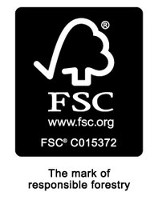Combating deforestation is a key part of the effort to stop climate change. As a result, dozens of certification programmes have been introduced worldwide, with Forest Stewardship Council (FSC) and Programme for the Endorsement of Forest Certification (PEFC) being two of the most popular ones. In this article we’ll learn what each term stands for and what is the difference between FSC and PEFC.
What does ‘sustainable wood’ mean?
Sustainable wood was obtained legally, from sustainably managed forests. This means they’re cared for by forest stewards who are focused on long-term sustainability, as opposed to short-term gains from exploiting woodland areas. Sustainable management practices involve protecting the ecosystems, watersheds, wildlife and other trees, as well as replanting the trees that are felled.
What is FSC certification?

The Forest Stewardship Council (FSC) is a global organisation that promotes responsible stewardship through 10 principles. It aims to maintain environmental, economic, and social standards by focusing on both forest management and chain of custody. The FSC scheme was initially developed for tropical environments. The standard needs to be interpreted at national level in order for it to be implemented within local forests. The FSC certificate system covers over 180 million hectares and is recognised in 80 countries.
What is PEFC certification?
.png)
The Programme for the Endorsement of Forest Certification (PEFC) is an international non-profit organisation that also focuses on sustainable forest management and supply chain monitoring. It was introduced in the late 1990s to accommodate the needs for sustainable forest management in Europe and North America. The PEFC certificate is the largest certification system in the world, with more than 280 million hectares of forest certified and recognition in 30 countries.
What is the difference between FSC and PEFC?
Both certifications are committed to sustainable forest management, yet there are several differences in how they achieve it:
- - The FSC certification sets the global standard for managing forests which can then be nationally adapted. The PEFC certification, on the other hand, is not a standards agency but a mutual recognition scheme (i.e. an umbrella organisation). It assesses every country’s independent forestry management schemes against international criteria.
- - The FSC was established to prevent illegally sourced timber from being used and placed greater focus on the environmental side of things. The PEFC builds on top of FSCm, but is adapted for small-scale land owners.
- - FSC is a second-party certification meaning that the organisation itself issues the certificates. On the contrary, PEFC is a third-party certification and uses independent certification bodies to issue the certificates.
Can a product be both FSC and PEFC certified?
Yes, it can. Some forests around the world choose to hold both types of certification, most likely in order to satisfy the growing environmental requirements of developers and contractors. The UK government states that both FSC and PEFC are compliant with its legality and sustainability criteria.
Why you should choose certified timber
Choosing wood from certified forests means that it’s traceable throughout the processing, transport, and use. This transparency can give you the confidence that you’re truly using a renewable material sourced in a responsible and environmentally-conscious way that doesn’t damage habitats or have a negative environmental impact.

Is sustainable wood more expensive?
Sustainably sourced wood can be more expensive than wood that doesn’t comply with national requirements and international certifications. That’s due in part to the additional steps that PEFC or FSC certified timber needs to undergo to ensure that it is harvested in a responsible manner. Another reason is that it’s produced in smaller quantities instead of ‘overcutting’ which aggravates deforestation and subsequently soil erosion, flooding, CO2 emissions, etc. In addition, sustainable timber is sourced and processed using fair labor, which excludes child labor, forced labor, etc.
However, as with other certified goods, this added effort and care results in high-quality timber improved longevity and durability. This can lead to cost savings in the long run and greater resource efficiency.
How do you know if timber is sustainably sourced?
When purchasing wood, look for manufacturers and suppliers bearing the respective label indicating FSC or PEFC certified timber. Luxury Wood is committed to supplying high-quality products from reputable sources that fulfill the applicable standards. This includes timber from sustainable forests, ENplus® and BSL certified pellets, Ready to Burn wood fuel, and more.
Now that we’ve covered important questions such as ‘What is certified sustainable timber?’ and ‘What is the difference between FSC and PEFC?’, you’re equipped to recognize sustainable wood, and purchase and use it with a clear conscience, knowing that you’re getting a high-quality product that doesn’t cause long-term damage to the environment and forest area communities.


